
The Long Haul
by Jocelyn Duffy
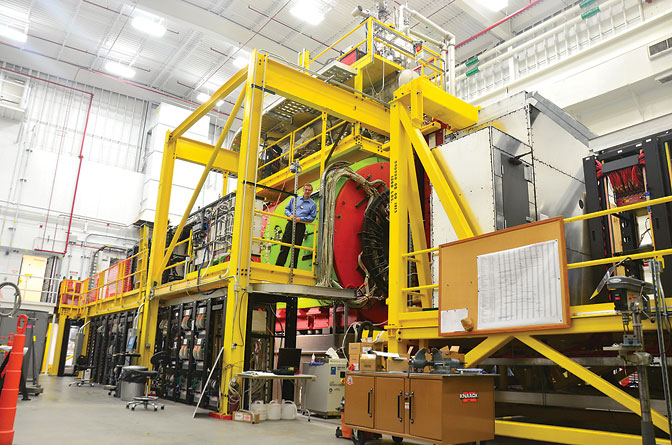
Curtis Meyer standing on the GlueX Platform in front of the upstream bore of the GlueX solenoidal magnet. The CDC is visible in the bore of the magnet. Image courtesy Jefferson Lab Public Relations
It was almost like sending a child off to college—after 17 years of work, Carnegie Mellon Professor Curtis Meyer watched as the particle detector that he and his colleagues had constructed in Wean Hall was packed up, loaded into a moving van and sent off to its new home, the Jefferson Lab National Accelerator Facility in Newport News, Va. The detector will aid in the search for hybrid mesons, particles that can help us to understand the glue that holds everyday matter together.
Seventeen years ago, Physics Professor Curtis Meyer and colleagues from an international group of universities and national labs started to plan the GlueX experiment, a project that endeavors to help physicists answer one of the most fundamental questions in physics: how do quarks bind together to form the building blocks of matter?
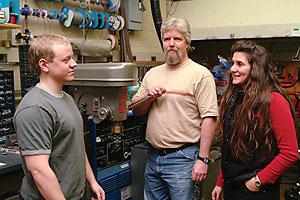
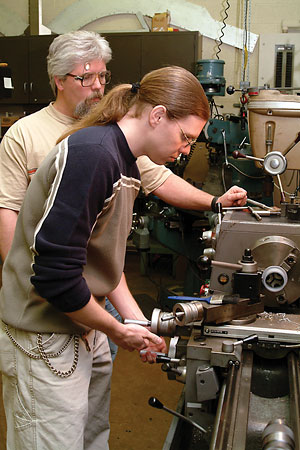
Top: Graduate student Michael Williams, technician Gary Wilkin, and postdoctoral associate Angella Biselli discussing the construction of the Central Drift Chamber (CDC) in the Medium-energy shop in Wean Hall.
Bottom: Gary Wilkin and graduate student Joe Parker turning out a part for the CDC in the Medium-energy shop in Wean Hall. Photos courtesy Department of Physics.
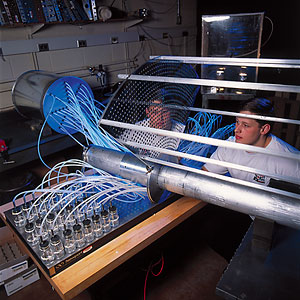
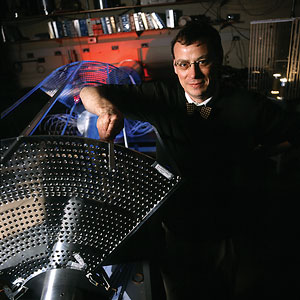
Top: Graduate student Zeb Krahn tests gas flow through tubes of the prototype GlueX detector. uniform gas flow is critical for optimum performance of the detector.
Bottom: Curtis Meyer, professor of physics and spokesman for the GlueX experiment, with the prototype central tracking device being built and tested at Carnegie Mellon. The central tracking device will be one of 10 major systems making up the final detector to be located in JLab’s Hall D.
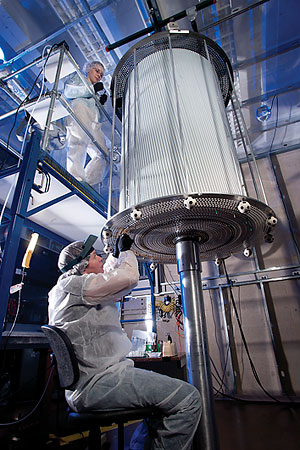
Technician Amy Woodhall (bottom) and CMu undergraduate Maddi Brumbaugh inserting thin- walled straw tubes into the CDC during its construction in the clean room in Wean Hall. Over 3,500 straws were glued into the CDC during its construction. Photo by Ken Andreyo.
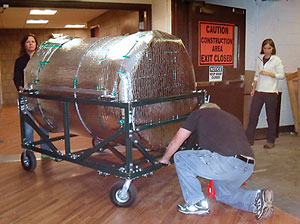
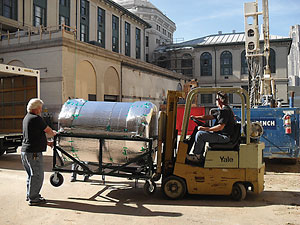
Top: Amy Woodhall (behind the CDC), Gary Wilkin and postdoctoral associate Naomi Jarvis inspect the insulation and bubble wrap around the CDC prior to loading it on the transport van. The wheeled cart was specially designed with shock absorbers and the air pressure in the tires was lowered during transport to Jefferson Lab.
Bottom: Gary Wilkin oversees the loading of the CDC into the transport van for transportation to Jefferson Lab. Forklift assistance was provided by the Mechanical Engineering Department. Photos courtesy Department of Physics.
But as every physicist knows, to study elements of matter as small as quarks, you needone of the largest and most expensive pieces of equipment known to science—a particle accelerator. GlueX is a member of the next generation of experiments to be done with the Continuous Beam Electron Accelerator housed at the Jefferson Lab National Accelerator Facility (JLab) in Newport News, Va. The accelerator became operational in 1994. In 1997, researchers began to think about what would be next for the accelerator. They decided that they’d use the facility to search for hybrid mesons, a theoretical particle that can be used to understand gluons, the particles that bind matter together.
But, in order to accelerate particles at an energy high enough to study the gluons, the scientists knew that the accelerator would have to undergo a significant upgrade. They embarked on a $340M project that would increase the accelerator’s energy from 6 billion electron volts (GeV) to 12GeV. As part of the upgrade, they constructed a new experimental building, Hall D, that houses a new, state-of-the-art experiment made up of particle detectors that will capture signals created by subatomic particles. One of the detectors, called the central drift chamber (CDC), was constructed at Carnegie Mellon by Meyer’s research group in his Wean Hall lab.
Building such a detector is a precise process that is usually only done at large national laboratory facilities such as Illinois’s Fermilab, or California’s SLAC National Accelerator Laboratory. Having previously built a similar detector for another project, Meyer’s lab is one of only a few at a university with the facilities and expertise to complete such a task.
“Very few places have the infrastructure necessary to build a detector,” Meyer said. “We’re very fortunate to have the expertise and resources to build this here at Carnegie Mellon.”
First, the university constructed a Class 2000 clean room on the 8th floor of Wean Hall that was specially designed to prevent airborne pollutants from entering its protective plastic-walled chamber. Meyer’s lab group began to manufacture and assemble the skeleton of the CDC inside the clean room. After the skeleton was completed, they hung it from the ceiling. From 2009 until 2013, at any given time of the day, you could find students and technicians clothed in protective jumpsuits and caps hovering on ladders above or sitting below the CDC, painstakingly installing its delicate pieces. The CDC consists of a hollow tube surrounded by 3,522 five-foot-long aluminum and plastic tubes. Secured between two plates, the tubes are layered in 28 concentric circles. Gold-plated tungsten wires five times thinner than a human hair are threaded down each tube. In all, it took three miles of wire and countless hours to assemble. Meyer’s group finished the CDC in early 2013, and in November of that year it came time to move it to its home in Virginia.
Moving the approximately 400 pound chamber was no easy feat. The detector couldn’t withstand any big shocks and needed to be kept at a fairly constant temperature to avoid mechanical stresses. Meyer’s group secured a truck that was open to the cab, which allowed them to easily control the temperature. The detector itself was built on a specialized cart equipped with shock absorbers—students had earlier tested the cart by wheeling a prototype around the uneven sidewalks of campus. The research group removed some of the electronics from the detector, and wrapped the detector in bubble wrap. The cart was then wheeled to the Wean Hall loading dock, loaded onto the waiting truck and secured to the corners of the bed.
Since the JLab facility wasn’t open at night, the truck and detector spent an evening at the house of technician Gary Wilkin. Wilkin helped Meyer deliver another detector 20 years ago, making him the resident expert in moving large-scale physics equipment. The next morning Wilkin and technician Amy Woodhall set off for Virginia. They followed a carefully mapped out 8-hour route to Newport News, specifically avoiding the notoriously busy highways around Washington, D.C. Meyer’s postdoctoral researcher and students made a test drive of the route in the weeks before the move to troubleshoot any possible road closures or obstacles that might lie in the way.
The drive went smoothly, and after they arrived at JLab, Wilkin and Woodhall drove the truck into Hall D and unloaded the detector. The detector was installed in early 2014, and the newly upgraded accelerator sent its first beam of photons to Hall D in early November. Images of events recorded in Meyer’s CDC gave the researchers the very first indication that the experiment was working. Engineering runs should be completed by mid-2015, and researchers will start doing physics by 2016.
It’s then that the GlueX experiment will get underway. Researchers involved with GlueX, including Meyer, hope to find a new type of subatomic particle called a hybrid meson. The particle should reveal pertinent information about gluons.
Gluons bind together quarks, the component parts of protons, neutrons and mesons. Mesons are particles made up of a pair of quarks held together by gluons with no charge. The gluons in hybrid mesons—which have been theorized and hinted at in experiments—are thought to be in an excited state. This gives the mesons unusual, or “exotic,” quantum numbers that are a signature of the hybrid particles. Meyer and his collaborators hope that if their detectors find these hybrid mesons, they will be able to derive pertinent information about gluons. When it’s up to speed, the accelerator will use its 12 billion volts of energy to hurl electrons around a 7/8-mile-long racetrack.
The electrons will be extracted from the track and passed through a thin diamond crystal. High-energy photons—which are the elementary particles of light—will be sent toward a liquid-hydrogen-filled vessel at the center of the CDC. When the photons hit a proton inside the liquid-hydrogen-filled chamber, the collision will produce a variety of subatomic particles that will soar outward through the detector’s tubes, which are filled with argon and carbon dioxide. As the particles fly through the tubes, the gas will ionize and send a charge through the wires at the center of the tubes.
“Each of the tubes will be an individual Geiger counter,” Meyer said. “We’ll have 3,522 Geiger counters generating information about the particles created by the collision.”
The researchers will analyze the trajectory of each particle. Based on the trajectory, they’ll be able to calculate the momentum and other characteristics of the particles.
“Previous experiments using photon beams were only able to collect small amounts of data. In GlueX, we will increase the world’s statistical data from photon beams by several orders of magnitude,” Meyer said. “This will make the detailed study of the physics behind the reactions possible and allow us to see the exotic hybrid mesons—if they exist.”
This will mark the first time large amounts of data have been taken from photons. Meyer expects the data set to be in petabytes. While this much data could be daunting, the multi-institutional group working on the JLab experiment has come up with a relatively low-tech way to analyze the information using standard computer video processors. These processors are so small that they can fit 1,024 of them in the space of one hard drive.
“It turns out that graphical processor units can do the types of calculations we need faster than most other processors,” Meyer said. “It only works on specific types of problems; luckily ours was one of them.”
When the GlueX team begins collecting and analyzing data, they hope to piece together how gluons and quarks interact. They will compare what they learn to current theories, like the theory of quantum chromodynamics.
“We hope to reach a fundamental understanding of how these particles behave. It’s going to give us a better idea of how the fundamental pieces of the universe work,” said Meyer. “And that’s exciting.”
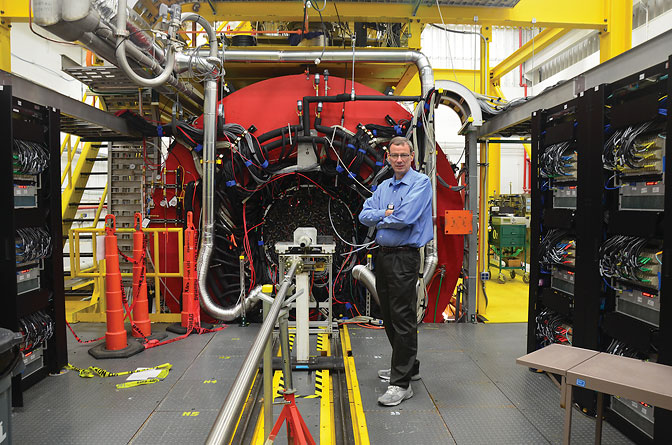
Curtis Meyer standing on the GlueX Platform in front of the upstream bore of the GlueX solenoidal magnet. The CDC is visible in the bore of the magnet. Image courtesy Jefferson Lab Public Relations